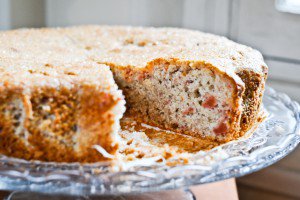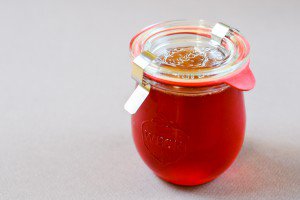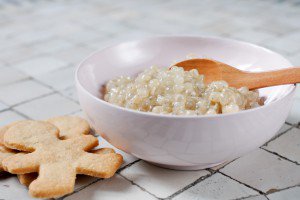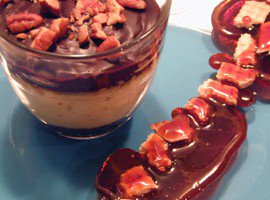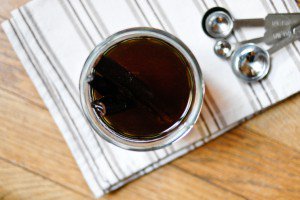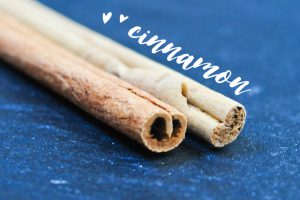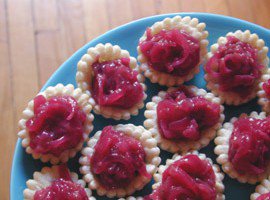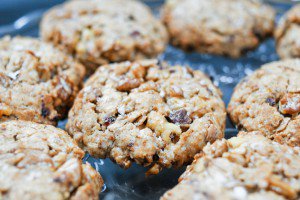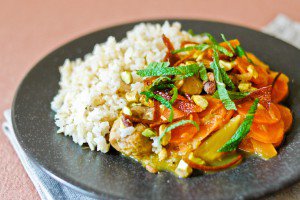Where’s the online scratch ‘n sniff when you need it?
Since such technology is not yet available to us (sheesh!), we’ll just have to rely on our imagination and invoke, in our mind’s nose, the irresistibly sweet, floral, candy-like scent that quince, the most gnarled and unprepossessing subject of the fruit kingdom, emits.
In fact, if you were to cook quinces right away upon purchasing them, I would call you crazy: what you should do instead is keep them for a few days on a platter somewhere, in your kitchen or living room, where they’ll act as a natural home fragrance.
If you were to cook quinces right away upon purchasing them, I would call you crazy: what you should do instead is keep them for a few days on a platter somewhere, in your kitchen or living room, where they’ll act as a natural home fragrance.
When you’re done near-fainting with felicity every time you take a whiff, it’s time to poach them and enjoy the second surprise they have in store: the flesh of quince, which doesn’t look like much and tastes horrible when raw, takes on a ravishing, ruby pink shade* and a most palatable flavor when cooked.
Because quince has a high pectin content, quince paste (or dulce de membrillo, or jam, or jelly) is the most common use for it, but these preparations are usually too sweet for my taste, and I prefer my quinces as a compote, poached in a not-too-sweet syrup**.
After a few hours of simmering — yes, it takes that long — the wedges become soft, with a pleasantly grainy textural veil, and taste like a cross between an excellent apple and an even better pear, with underlying notes of honey and spice.
There is one caveat, and it has certainly tainted the reputation of quince with cooks everywhere: it is rather laborious to peel and quarter and core: unlike the pear and apple, its comelier cousins, it opposes the blade with an almost wood-like resistance. Sharpening your knives helps, as does wearing gloves, recruiting a commis, and/or cursing under your breath every once in a while.
Quince is an autumn fruit, so look for yellow and downy specimens now, at the greenmarket or in somebody’s orchard — it is my understanding that most quince trees*** produce a lot more fruit than anyone in their right mind is willing to deal with, so the owner may be happy to part with a few.
I eat poached quince for breakfast, with homemade yogurt and muesli, but it can also be served for dessert, slightly warm, with a scoop of almond milk ice cream and a butter cookie. You can also use the drained chunks of fruit in a tender cake or tart, pair them with a piece of sharp cheese (blue cheese, or a firm sheep’s milk cheese such as manchego), or serve them as a side to roasted duck or game.
~~~
* Lucy, over at Nourish Me, has pictures of the transformation.
** As a rule of thumb, I use about 10% sugar: 10 grams of sugar for every 100 grams of trimmed quince flesh. The compote can then be used with sweet or savory dishes; and if I want it sweeter, I can always add a little honey.
*** In French, quince = le coing; quince tree = le cognassier.

Have you tried this? Share your pics on Instagram!
Please tag your pictures with #cnzrecipes. I'll share my favorites!
Ingredients
- 2 kg (4.4 pounds) ripe quinces, about 8 (a ripe quince is chiefly yellow, with faint green highlights)
- 160 grams (3/4 cup, packed) unrefined cane sugar
- 1 pod vanilla
Instructions
- Place the quinces in the sink, cover with warm water, and rub them in the water to remove the fuzzy down on their skin. Rinse, drain, and dry.
- Peel the quinces with a vegetable peeler. Using a very sharp knife, cut each quince in quarters, carve out the core, and cut into wedges. This is a bit of a workout; be extremely cautious with that knife and try not to gash your hand open.
- Fill a heavy cast-iron pot with 2 liters (8 cups) water and the sugar. Bring to a simmer and add the quince. Split the vanilla pod open lengthwise, scrape out the seeds with the dull side of a knife blade, and add the seeds and pod to the pot. Stir to combine.
- Cover and keep at a low simmer for 2 1/2 to 3 hours, stirring regularly but gently, until the fruit is soft and ruby-pink. Remove the lid for the last half-hour so the syrup will reduce a bit.
- Place the quinces, the sugar and the vanilla in the pressure cooker, and add in water just to cover the fruit. Cook for 30 minutes starting from the whistle of the safety valve.
- Let cool, cover, and refrigerate until the next day, to let the flavors settle and develop. Poached quinces freeze splendidly, too.



